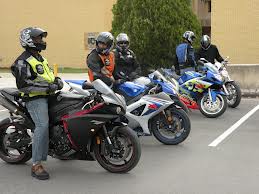The significance and issues of motorcycle transport in the Urban areas in northern Ghana
Keywords:
Motorcycle;Motor traffic;DevelopmentAbstract
In many developing countries, motorcycles are increasingly becoming the common means of transport especially among low-income urban dwellers (urban poor) and many rural people. The high ownership and use of motorcycle in the urban areas in northern Ghana has come with its accompanying challenges like motorcycle accidents involving fatalities; environmental and public health concerns from the emissions; non-compliance to motor traffic regulations-for instance helmet use is generally low in Ghana among others among other things. The high incidence of motorcycle ownership and use has also been contributing significantly in the betterment of many livelihoods of urban residents in northern Ghana and at the instance of Wa. The increasing growth in the number of motorcycles has come to solve the mobility needs of many urban residents in the light of poor and inadequate public transport system, poor road conditions particularly those leading into the peri- urban areas where many people in Wa reside as a result of urban sprawl. It also comes along with a host of opportunities including employment to motorcycle mechanics and motorcycle spare parts dealers, local revenue generating sources through taxes/levies on motorcycle owners/riders as well as motorcycle registration and licensing. This paper examines the effects of motorcycle growth in the social and economic development or livelihoods of Wa, the regional capital of the Upper West Region of Ghana.
References
Button K.J., Hensher., 2001. Handbook of Transport Systems and Traffic control. Pergamon, U. K.
Charles, M., 2011. The Effects of the Revolution of Motorcycle Transport on the Economic Growth of Kenya. A Case Study of Thika District. MBA Thesis submitted to the School of Business, KCA University, Kenya.
Dawson, C., 2009. An Introduction to Research Methods; A Practical Guide to anyone undertaking a Research Project, Fourth edition, How To Books Ltd, U.K.
Department of Environment., Transport and the Regions (DETR)., 2000. Tomorrow’s Roads – Safer for Everyone: The Government’s road safety strategy and casualty reduction targets for 2010. DETR Report. London. HMSO.
Gauthier, A. & Hook, W. (2005):Tapping the market for quality bicycles in Africa. Sustain. Transport., 19, 8-11, 30.
Gauthier, A., 2005. Scaling up for Healthcare Mobility in Africa. Sustain. Transport., 19, 20-23, 25.
Gbadamosi, K.T., 2002. The Emergence of Motorcycle in Urban Transportation in Nigeria and its implication on Traffic Safety; Center for Transport Studies, Department of Geography and Regional Planning, Olabisi Onabanjo University, P.M.B 2002; Ago-Iwoye, Ogun State, Nigeria.
Ghana Statistical Service., 2000. Population and Housing Census 2000, Ghana, Accra.
Gina, P., 2002. Intermediate Means of Transport; A Review Paper with Special Reference to Ghana, Depart. Anthropol., University of Durham, U. K.
GSS., 2008. Ghana living standards Survey; report of the Fifth Round (V). Accra.
Howe, J., Barwell, I., 1987. Study of Potential of Intermediate Means of Transport, Vol.2. I.T Transport.
http://en.wikipedia.org/wiki/file assessed in March, 2013.
International Council for Clean Transportation (ICCT)., 2009. Two –and-Three Wheelers in India. Innovative Transport Solutions (iTrans). Pvt.Ltd., TBIU, IITDehli, New Dehli.
Kamakate, F., et al., 2009. Managing Motorcycles: Opportunities to Reduce Pollution and Fuel Use from Two-and-Three wheeled Vehicle. Int. Council on Clean Tran(ICCT)., USA.
Kumar, A., World, B., 2011. Understanding the Emerging Role of Motorcycles in African Cities: A Political Economy Perspective. SSATP Discussion Paper No. 13. Urban Transport Services. Int. Bank Reconstr. Dev., / The World Bank.
Leinbach, T.R., 2000. Mobility in development context: changing perspectives, new interpretations, and the real issues. J. Tran. Geogr., 8, 1-9.
Luci, A., 2010. Res. Des. Methodol. Wits University Graduate School of Public and Development Management.
Munby, D., 1968. Transport. Harmondo North. Middlesex. England.
Nguyen, A., Nam., 2007. Master Plan for the Development of Vietnams Motorcycle Industry in the Period of 2006-2013 with a Vision to 2020. Ministry of Industry and Institute of Industry Policy and Strategy. Vietnam.
Mohan, D., et al., 2002., Traffic safety and health in Indian cities. J. Tran. Infrastruct., 9, 79–94.
PCFV/UNEP., 2006. Cleaner Motorcycles: Promoting the use of Four-Stroke Engines. Partnership for Clean Fuels and Vehicles under the United Nations’ Environment Program, Nairobi, Kenya.
Perco, P., 2008. Comparison Between Powered Two Wheeler And Passenger Car Free-Flow.
Speeds In Urban Areas. In, CD-ROM. Transportation Research Board, National Research Council, Washington, D.C.,
Starkey, P., Ellis, S., Hine, J., Ternell, A., 2002. Improving Rural Mobility: Options forDeveloping Motorized and Non-motorized Transport in Rural Areas. World Bank Technical Paper., No. 525.
Tengey, W.S., et al., 1999. Rural Transport Services and Gender in Ghana; Study Report. Gend. Dev. Inst., Accra, Ghana.
World Bank., 2002. India’s Transport Sector: The Challenges Ahead. The World Bank, Washington, DC.
World Bank., 2002. Cities on the Move: A World Bank Urban Transport Strategy Review.
Washington, D.C., World Bank Publications.
World Health Organization., Geneva., 2004., World report on road traffic injury prevention. Edited by Peden Margie and others.

Published
How to Cite
Issue
Section
Copyright (c) 2013 R. D. Dinye

This work is licensed under a Creative Commons Attribution-NonCommercial-NoDerivatives 4.0 International License.



